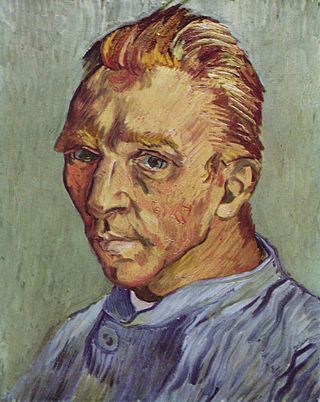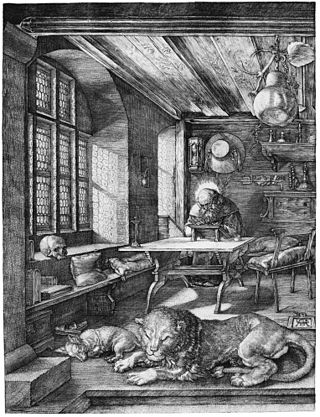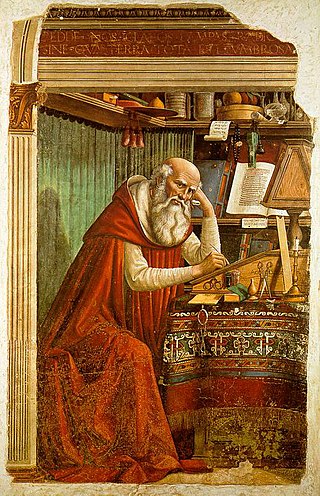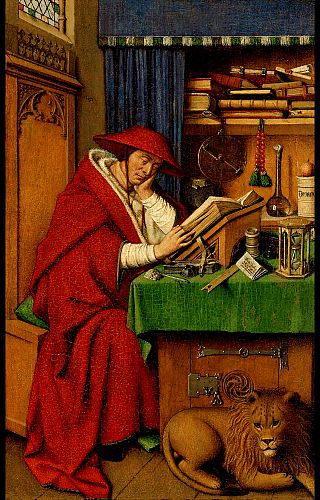Saint Jerome in His Study may refer to the following artworks depicting Saint Jerome:

Albrecht Dürer, sometimes spelled in English as Durer, was a German painter, printmaker, and theorist of the German Renaissance. Born in Nuremberg, Dürer established his reputation and influence across Europe in his twenties due to his high-quality woodcut prints. He was in contact with the major Italian artists of his time, including Raphael, Giovanni Bellini, and Leonardo da Vinci, and from 1512 was patronized by Emperor Maximilian I.
Visitation may refer to:

Renaissance art is the painting, sculpture, and decorative arts of the period of European history known as the Renaissance, which emerged as a distinct style in Italy in about AD 1400, in parallel with developments which occurred in philosophy, literature, music, science, and technology. Renaissance art took as its foundation the art of Classical antiquity, perceived as the noblest of ancient traditions, but transformed that tradition by absorbing recent developments in the art of Northern Europe and by applying contemporary scientific knowledge. Along with Renaissance humanist philosophy, it spread throughout Europe, affecting both artists and their patrons with the development of new techniques and new artistic sensibilities. For art historians, Renaissance art marks the transition of Europe from the medieval period to the Early Modern age.

The Kunsthistorisches Museum is an art museum in Vienna, Austria. Housed in its festive palatial building on the Vienna Ring Road, it is crowned with an octagonal dome. The term Kunsthistorisches Museum applies to both the institution and the main building. It is the largest art museum in the country and one of the most important museums worldwide.

The Alte Pinakothek is an art museum located in the Kunstareal area in Munich, Germany. It is one of the oldest galleries in the world and houses a significant collection of Old Master paintings. The name Alte (Old) Pinakothek refers to the time period covered by the collection—from the fourteenth to the eighteenth century. The Neue Pinakothek, re-built in 1981, covers nineteenth-century art, and Pinakothek der Moderne, opened in 2002, exhibits modern art. All three galleries are part of the Bavarian State Painting Collections, an organization of the Free state of Bavaria.

The Thyssen-Bornemisza National Museum, or simply the Thyssen, is an art museum in Madrid, Spain, located near the Prado Museum on one of the city's main boulevards. It is known as part of the "Golden Triangle of Art", which also includes the Prado and the Reina Sofía national galleries. The Thyssen-Bornemisza fills the historical gaps in its counterparts' collections: in the Prado's case this includes Italian primitives and works from the English, Dutch and German schools, while in the case of the Reina Sofía it concerns Impressionists, Expressionists, and European and American paintings from the 20th century.
Supper at Emmaus is an event in the Gospel of Luke.

Simon Bening was a Flemish miniaturist, generally regarded as the last major artist of the Netherlandish tradition.

Joos van Cleve was a leading painter active in Antwerp from his arrival there around 1511 until his death in 1540 or 1541. Within Dutch and Flemish Renaissance painting, he combines the traditional techniques of Early Netherlandish painting with influences of more contemporary Renaissance painting styles.

A self-portrait is a portrait of an artist made by themselves. Although self-portraits have been made since the earliest times, the practice of self-portraiture only gaining momentum in the Early Renaissance in the mid-15th century that artists can be frequently identified depicting themselves as either the main subject, or as important characters in their work. With better and cheaper mirrors, and the advent of the panel portrait, many painters, sculptors and printmakers tried some form of self-portraiture. Portrait of a Man in a Turban by Jan van Eyck of 1433 may well be the earliest known panel self-portrait. He painted a separate portrait of his wife, and he belonged to the social group that had begun to commission portraits, already more common among wealthy Netherlanders than south of the Alps. The genre is venerable, but not until the Renaissance, with increased wealth and interest in the individual as a subject, did it become truly popular.
The decade of the 1490s in art involved some significant events.

Saint Augustine in His Study is a fresco painting of Augustine of Hippo executed in 1480 by the Italian Renaissance master Sandro Botticelli. It is in the church of Ognissanti in Florence.

The National Gallery is the primary British national public art gallery, sited on Trafalgar Square, in central London. It is home to one of the world's greatest collections of Western European paintings. Founded in 1824, from an initial purchase of 36 paintings by the British Government, its collections have since grown to about 2,300 paintings by roughly 750 artists dating from the mid-13th century to 1900, most of which are on display. This page lists some of the highlights of the collection.

Saint Jerome in His Study is a copper engraving of 1514 by the German artist Albrecht Dürer. Saint Jerome is shown sitting behind his desk, engrossed in work. The table, on the corner of which is a cross, is typical of the Renaissance. An imaginary line from Jerome's head passing through the cross would arrive at the skull on the window ledge, as if contrasting death and the Resurrection. The lion in the foreground is part of the traditional iconography of St. Jerome, and near it is a sleeping dog, an animal found frequently in Dürer's works, symbolizing loyalty. Both creatures are part of Jerome's story in the Golden Legend, which contained fanciful hagiographies of saints.

Saint Jerome in His Study is a fresco by the Italian Renaissance painter Domenico Ghirlandaio, executed in 1480 and located in the church of Ognissanti, Florence.

Saint Jerome in His Study is an oil painting on panel no larger than an oversized postcard attributed to the workshop of the early Netherlandish painter Jan van Eyck and is currently in the collection of the Detroit Institute of Arts. Purchased in 1925 by museum director Dr. W.R. Valentiner, the small Flemish painting at that time was attributed to Petrus Christus. The painting depicts St. Jerome, the 4th-century translator of the Bible, reading in his study, wearing a cardinal's dress and hat. He is surrounded by objects exemplyfying late medieval intellectual life and accompanied by the pet lion that is his common attribute.
Saint Jerome in the Wilderness or Saint Jerome in the Desert is a common subject in art depicting Jerome. In practice the same subject is often given titles such as Saint Jerome in Penitence and Saint Jerome Praying. Versions usually given a "wilderness" or "desert" title include:

Lotte Brand Philip was a German art historian, professor and expert on Netherlandish art, one of the most notable and incisive experts on 14th- and 15th-century art to have studied under Erwin Panofsky. Born a Christian of Jewish descent, she resisted state intimidation to leave Germany, only moving to the United States in 1941. She began her new life as a jewelry designer, before establishing a career as an art historian and writer, and taking professorship at a number of universities, including New York University and Queens College, Flushing. During her long career, Brand wrote highly regarded books and monographs on artists such as Jan van Eyck, Albrecht Dürer and Hieronymus Bosch, and in 1980 became emeritus at Queens. Brand Philip died on May 2, 1986, in New York City.
Portrait of a Man may refer to:

The Vision of Saint Eustace is a painting by Annibale Carracci, showing saint Eustace and his vision of a crucifix between the horns of a stag whilst out hunting. The saint is set in one of the first landscapes by either of the Carracci brothers, showing how he was influenced by Venetian landscape painting until about 1598 after a stay in the city in 1587 and 1588. Specific influences include Titian's Penitent Saint Jerome (Louvre) and the naturalism of Jacopo Bassano. Critics argue the composition is based on two prints by Cornelis Cort, a Flemish printer - Penitent St Jerome and The Vision of Saint Eustace. These prints were in turn based on ideas by the Lombard painter Girolamo Muziano, who was also influenced by Venetian models. The dogs and some other details are drawn from Saint Eustace, an engraving by Albrecht Dürer of the same subject.